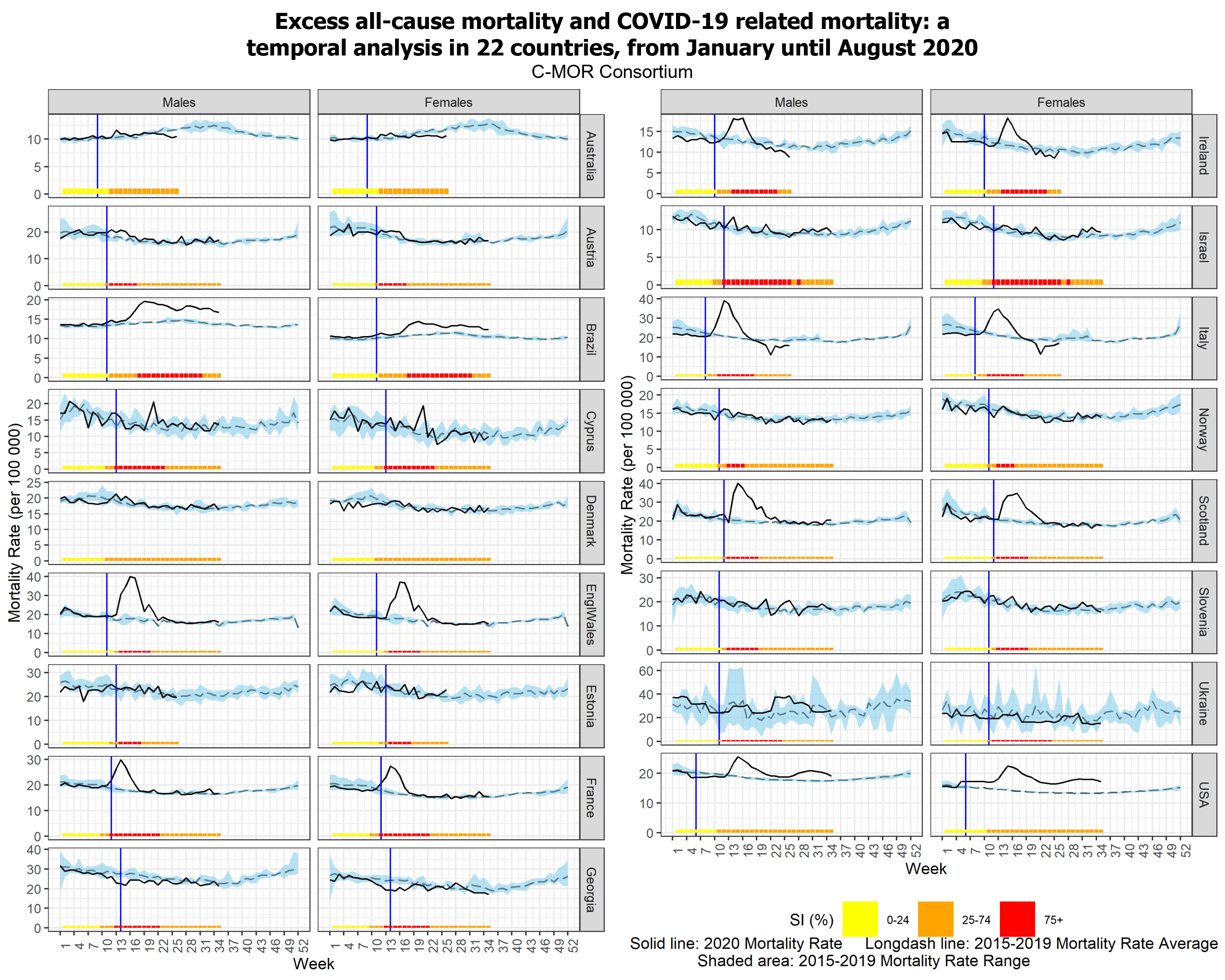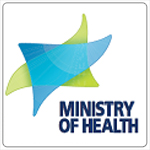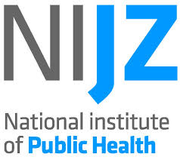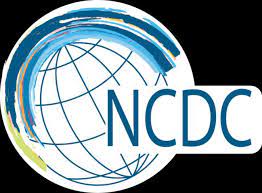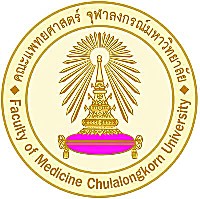COVID-19
UNIC Coronavirus Health and Research Portal
C-MOR – Research Consortium and Platform for Monitoring Overall and Cause-Specific Mortality Resulting from the COVID-19 Pandemic
About us
We are creating a reference dataset focused on mortality resulting from COVID-19. The consortium includes 58 institutions who lead our efforts in 52 countries. We have already published key results which analyze excess mortality from the pandemic up to August 2020. Currently, the consortium is focusing on whole-of-2020 excess mortality along with potential-years-of-life-lost from COVID-19. Our goal is for this work to aid in the response to this pandemic and future ones.
Excess all-cause mortality and COVID-19-related mortality: a temporal analysis in 22 countries, from January until August 2020
Since the earliest weeks following the emergence of SARS-CoV-2, it has been a challenge to understand the impact of the pandemic on mortality. COVID-19 death counts do not account for limited testing, upended healthcare systems, and deaths stemming from restriction measures. In short, countries worldwide are lacking an accurate picture of the direct and indirect mortality burden from COVID-19.
UNIC and research partners took note of this problem and devised the sort of global-scale project needed to address it. They launched the COVID-19 Mortality (C-MOR) Consortium focused on measuring excess mortality, which has grown to include 58 institutions across 6 continents and 52 countries.
Consortium partners in 22 of these countries were able to navigate through shared challenges of collecting and analysing five years of mortality data. Their hard work and collaboration paid off with a truly global dataset focused on excess mortality from the inception of the pandemic through to August 2020.
This work was published this week in the International Journal of Epidemiology by the Oxford University Press. The results represent one of the largest and most expansive studies of mortality from the pandemic that predominantly utilized national and primary sources, as opposed to publicly available datasets.
What Does This Mean?
Researchers with on-the-ground experience were able to collect the data for each of their respective countries and, thereafter, assess all-cause deaths during the pandemic along with all-cause deaths during the same period in previous years. As such, the Consortium was able to more accurately measure how the pandemic affected mortality in countries across the globe.
- As emerging and re-emerging infectious diseases become more common, our results provide valuable lessons on the impact epidemics can have on populations and also offer insight on what can be done to mitigate this impact.
- As we face this politicized pandemic, the consortium is actively collecting accurate and timely surveillance data. We will not only continue to monitor excess deaths but will also begin to study the morbidity burden from COVID-19. These analyses will help us to better understand and minimize the multi-dimensional health effects of the virus.
While the valuable lessons in this study make their way to policy-makers and healthcare professionals, the Consortium remains hard at work to aid in the response to this pandemic and future ones.
The University of Nicosia (UNIC)
About the University of Nicosia
The University of Nicosia (UNIC) is the largest university in Cyprus, and the largest university in southern Europe that teaches primarily in English, welcoming 14,000+ students from over 100 countries worldwide. The University of Nicosia is a comprehensive university with 6 schools, 20 departments and over 100 degree programs offered on-campus and online.
The University of Nicosia is best known in the fields of medicine, law, blockchain, accounting, education, forecasting and international relations and for a series of partnerships with other leading European universities. These efforts, as well as its academic standing and global outlook are reflected in the University’s international ranking achievements, with UNIC ranking among the Top 300 universities in Europe and Top 1000 universities in the world, according to Times Higher Education (THE) World University Rankings.
To learn more about the University of Nicosia, please see: https://www.unic.ac.cy
UNIC’s COVID-19 Response
University of Nicosia faculty across a variety of academic disciplines are actively engaged in research and analysis and serving in scientific / public policy roles supporting the global COVID-19 response.
For more information about the University of Nicosia’s work relating to COVID-19 including potential collaboration, please see: https://www.unic.ac.cy/coronavirus/
Contact Information
To find out more about C-MOR and how to get involved please visit https://www.unic.ac.cy/coronavirus/mortality/ or email the C-MOR project coordinator at [email protected]
Partners
Thus far, we have 58 partners across 6 continents.
| Country | Institution |
| Spain | University of Oviedo |
| Sweden | Karolinska Institutet |
| Belgium | European Commission, Joint Research Centre |
| Greece | National School of Public Health |
| Ireland | Health Protection Surveillance Centre |
| UK | St George’s, University of London |
| Imperial College London | |
| Cardiff University | |
| US | University of Texas Medical Branch |
| University of South Carolina | |
| Australia | Deakin University |
| Western Australia Department of Health | |
| Monash University | |
| St John Ambulance Western Australia | |
| Israel | The Israel Center for Disease Control Ministry of Health |
| Lebanon | Lebanese American University |
| Thailand | Chulalongkorn University, Faculty of Medicine |
| Brazil | Universidade Federal Fluminense |
| Instituto de Estudos em Saúde Coletiva, Universidade Federal do Rio de Janeiro | |
| Georgia | National Statistics Office of Georgia |
| National Centre for Disease Control and Public Health | |
| Tbilisi State Unversity | |
| Norway | University of Oslo |
| Slovenia | National Institute of Public Health |
| University of Ljubljana | |
| Bahrain | University of Bahrain |
| Kuwait | Kuwait University |
| Guinea | Kofi Annan University of Guinea |
| Bulgaria | Medical University – Sofia |
| France | French School of Public Health |
| Germany | LMU Munich |
| Bhutan | Royal Thimphu College |
| Mongolia | Mongolia National University of Medical Sciences |
| Cameroon | University of Dschang |
| Guyana | American International School of Medicine |
| Italy | University of Perugia |
| Cape Verde | Universidade Jean Piaget de Cabo Verde |
| Sudan | University of Gezira |
| Austria | Medical University of Vienna |
| Uganda | Makerere University |
| Denmark | University of Copenhagen |
| Estonia | National Institute for Health Development |
| Colombia | Universidad Cooperativa de Colombia, campus Villavicencio |
| Taiwan | National Taiwan University |
| Mauritius | University of Mauritius |
| Algeria | Bejaia University |
| Université de M’Sila | |
| Ethiopia | Addis Ababa University |
| Zimbabwe | Great Zimbabwe University |
| Mexico | Monterrey Institute of Technology |
| Kazakhstan | Al-Farabi Kazakh National University |
| Egypt | American University in Cairo |
| Ukraine | National medical university O.O.Bogomolets of Kyiv, Ukraine |
| Bahrain, Kuwait, Oman, Qatar, Saudi and the UAE | Independent |
| Russia | Peoples’ Friendship University of Russia |
| Peru | Universidad del Pacífico |
| São Tomé and Príncipe | University of Sao Tome and Principe |
| Cyprus | University of Nicosia Medical School |
Epidemiological Objectives
- To investigate differences in all-cause and cause-specific mortality during the COVID-19 pandemic and over the same months in the previous 5 years, in selected countries.
- To determine the causes for any net differences in total mortality between the current pandemic period and the same period in previous years, in selected countries.
- To investigate possible underreporting of COVID-19 mortality in selected countries and apply a common way of counting deaths.
- To determine premature mortality as a result of the COVID-19 pandemic in selected countries.
- To investigate the long-term mortality burden of the COVID-19 pandemic, as well as the impact of potential subsequent epidemic waves in selected countries.
Data Collection Specifics
- Crude all-cause mortality, in weeks, from beginning of 2015 until end of December 2020
- Gender and Age specific all-cause mortality, in weeks, from beginning of 2015 until end of December 2020
- Total number of Covid-19 deaths, in weeks, from January 2020 until end of December 2020
- Gender and Age specific Covid-19 deaths, in weeks, from January 2020 until end of December 2020
- Where available: Crude cause-specific mortality, in weeks, from beginning of 2015 until end of December 2020
- Where available: Gender and Age specific cause-specific mortality, in weeks, from beginning of 2015 until end of December 2020
Process
As we compile data, our team is working to develop the following plots:
- COVID-19 weekly deaths and mortality rate, by country
- COVID-19 comparative mortality plots in different countries
- COVID-19 cumulative deaths vs new deaths in different countries
- Changes in the rate of dying by COVID-19 in different countries
- COVID-19 Overall Case-Fatality Rate by country
- COVID-19 cases vs deaths in different countries
- Weekly total (all-cause) mortality, by country
- Weekly total (all-cause) mortality over the pandemic as compared to same period in previous years, by country
- Weekly total (all-cause) and cause-specific mortality over the pandemic, by country
How You Can Help
We are actively searching for new partners in the C-MOR consortium, especially from the countries listed below. Our partners, with their on-the-ground experience, lead the consortium’s efforts for each of their respective countries. Joining C-MOR enables your country to be represented in this increasingly global dataset. Our partners have found this to be a rewarding opportunity to contribute in the pandemic response. If you have any interest in hearing more about this work, please reach out to us via the form below or by emailing the C-MOR project coordinator at [email protected]
Highest-priority countries
- India
- Canada
- China
- South Africa
- Argentina
- Chile
- Iran
- Japan
Consortium Updates
The C-MOR project at the 14th European Public Health conference
The 14th European Public Health (EPH) conference took place virtually on 10-12 November 2021. This year, the conference theme was “Public health futures in a changing world”. At the conference, two faculty members of the Department of Primary Care and Population Health were invited, through a competitive peer-reviewed abstract submission and selection process, to present the findings of the research undertaken under the umbrella of the C-MOR project.

